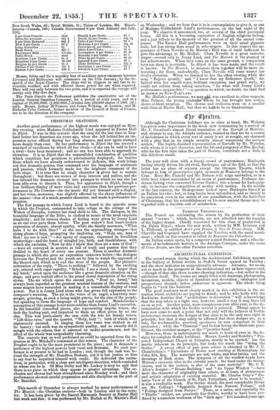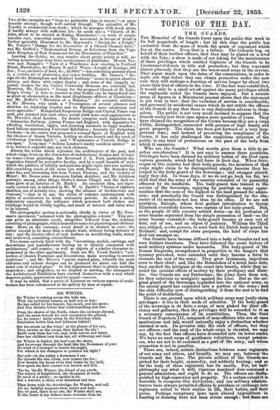ARCHITECTURAL EXHIBITION.
The second season during which the Architectural Exhibition appears in the Gallery of British Artists in Suffolk Street opened on Tuesday ; and the show indicates an unquestionable advance. Advance, we mean, not so much in the prospects of the architectural art as here represented, —though of that also there is some cheering indication,—but rather in the exhibition itself. The rooms are amply filled with drawings, photographs,, inventions, models, objects of furniture and decoration ; catalogues and prospectuses abound ; active endeavour is apparent. The whole thing begins to "look like business." The good tendency most clearly marked in this exhibition is the at- tention which architects are paying to detail ; and he who holds with the Ruskinian doctrine that "architecture is decoration" will acknowledge that the step taken is a right one, however small a way it may have led us on as yet. Another point, more conspicuous year after year, is the de- termination with which the Gothic revival is pursued. Things appear to have now come to such a point that not only will the believer in Gothic architecture maintain the designs of that class to be the only ones right in principle, but that it may safely be affirmed that these designs are, as a rule, the workmanlike, practical specimens by men competent in their profession ; while the " Classical " and Italian betray the third-rate prac- titioner, the crotchet-monger, or the "prentice hand."
However, there is unfortunately not much to boast of even in the de- signs for complete Gothic buildings. Messrs. Lander and Bedells's "Pro- posed Independent Chapel at Islington, shortly to be erected," has the merits inherent in its principle, but looks too much like "doing the Gothic." A sweet effect of pale pure colour is obtained in Mr. J. C. Chamberlain's "Elevations of House now erecting at Birmingham for John Eld, Esq. The materials are red, white, and blue bricks, and the dressings of Bath stone. The tympana of all the window-hes/1z have Minion's encaustic tiles in the circular panels : the band under the string- course, and in the cornice, is also of the same material." Mr. O. B. Allen's designs—" House-Building," and "An Upper Window "—have more the character of originality than others, or at least, of picturesque and artistic adaptation of existing material. Mr. Charles Gray's "Lx- tenor View of the Church of St. Paul, Tottenham, about to be erected," is also a creditable work. For Gothic detail, the most remarkable things are Mr. Colling's " Spandrils designed from Natural Foliage," and "Foliage designed from Nature." These, as a series, and especially the "Thistle" crocket, are genuinely fine Gothic, worthy to have been pro- duced by a nameless workman of the "dark ages" five hundred years ago. Two of the examples are "from no particular type in nature,"—a ques- tionable attempt, though well carried through. The specialite of Mr. Truefitt is ornamental iron-work ; which he manages with much grace, if hardly always with sufficient life : he sends also a "Church of St. John, about to be erected at Hulme, Manchester,' —a work of unmis- takeable style, somewhat sombre. The movement in favour of detail is further agreeably illustrated by Mr. Hayward's "Design for a Pulpit," Mr. Fisher's "Design for the Decoration of a Church Chancel-Arch," and Mr. Griffith's "Ecclesiastical Botany, or Selections from the Vege- table Kingdom of New Ornaments for the Decoration of Churches."
Leaving the Gothic, we may wander about pretty nearly at will, se- lecting monstrosities from their environment of platitudes. Messrs. Tra- vers and Mangall's "View of a Warehouse now erecting in Portland Street, Manchester, for Messrs. S. and J. Watts—Length of frontage, 300 feet ; Cost, exclusive of land, &e., 45,000C—has something genuine about it, a certain air of plutocracy and cotton lordship. Mr. James's " De- sign for the Birmingham and Midland Institute" seems to sprout abortive statues, and flares with vulgar display ; and some of the (happily re- jected) designs for the Oxford University Museum are curiously bad. However, Mr. Teulon's "Design for the proposed Church of St. Luke, King's Cross," is here to remind us that Gothic can be bastardized into as great an abomination as the most illegitimate offshoot of Classicism— say Mr. Heffer's " Elevation of a Mansion." An eccentric exhibitor is Mr. Moreau, who sends a " Frontispiece of several schemes and sketches for rendering London and its Environs more salubrious and more agreeable." Hungerford Suspension Bridge and Crystal Palace run mad, and jammed into each other, would yield some such agglomerate as Mr. Horeau's ideal London. Its details comprise such bagatelles as a " Submarine Railway, joining France and England, with apparatus for affording ventilation, lights, and directing mariners in foggy weather ; fixed balloon announcing Universal Exhibition ; fountain for Sydenham Gardens,—in the centre was proposed a colossal figure of England with the likeness of Queen Victoria, holding an olive-branch and the torch of civilization (electric light) "; and " Westminster or 'Victoria Bridge in one span." _Long may "reeking London's smoky cauldron simmer" as it is, before it explodes into any such chimera. Among the works which represent the architecture of the past, and which range between the characters of architectural designs and of regu- lar water-colour paintings, the Reverend J. L. Petit particularly dis- tinguishes himself by perceptive faculty, and by a rapid breadth of style which the addition of solidity and patience might ripen into true mastery. His crumbling touch of old stone vies with Front's. Mr. Boutcher has some fine and interesting bits from Venice, Prestum, and the vicinity of Mosul ; Mr. Deane some dexterous Italian sketches ; and Mr. Aitchison portrays, among other things, Giotto's Arena Chapel, and the dark so- lemn glow of an Interior of St. Mark's. An excellent idea, not vigor- ously carried out, is indicated in Mr. W. G. Smith's "Series of eighteen sketches, out of seventy-two, showing the alliance of Architecture and Costume,"—that is to say, the styles of costume contemporary with styles of architecture in many successive periods. In such a series, elaborately executed, the influence which governed both clothes and buildings would be vividly legible, and much of interest and value were to be learned.
The photographic section is noticeable chiefly in virtue of Mr. New- man's specimens "coloured with the photographic colours." This pro- Celle gives an admirable result, altogether different from the ordinary colouring of photographs, which is another name for plastering and oblitera- tion. Here, on the contrary, every detail is as distinct as ever ; the colour enough to be more than a simple wash, without losing delicacy of tint ; and the illusive effect of such matters as mouldering walls, mossy and mildewed, something extraordinary.
Two rooms entirely filled with the "inventions, models, carvings, and decorations and manufactures bearing on or directly connected with architecture," still remain ; as well as objects of a similar character in- terspersed in the other apartments., Such are Mr. Frank Smith's "col- lection of Church Furniture and Decorations, made according to ancient traditions" ; and Mr. Beeva's "patent stained glass, whereby the most elaborate and minute designs can be produced for about one half the usual cost of stained glass.' In this department there is plenty meriting inspection ; and altogether, as we implied at starting, the managers of the Architectural Exhibition have exerted themselves with a zeal which deserves public appreciation and its sequel—success. It may be added, that a series of Lectures on various aspects of archi- tecture has been commenced at the gallery by men of repute.



































 Previous page
Previous page